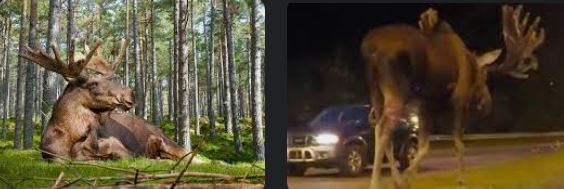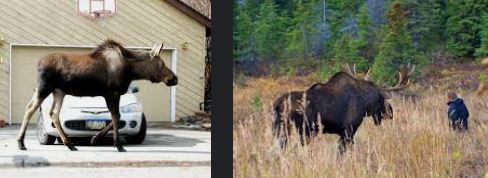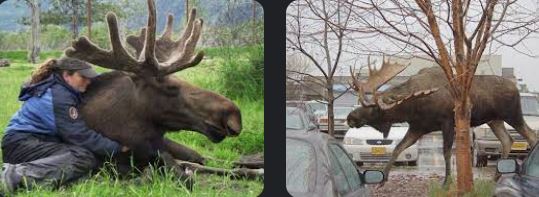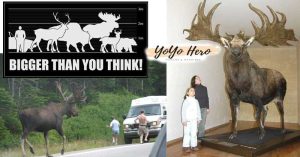Full-Size Moose Compared to Human-Moose Compared to Person-Moose vs. Human Size. The Majestic Moose: A Deep Dive into Their Size and Strength. Moose Uncovered: Understanding the Largest Member of the Deer Family
The moose’s extraordinary size and commanding presence have long been a topic of fascination. As we delve into this discussion, we intend to provide a comprehensive look at the size of this majestic creature, offering a detailed comparison with humans.
Moose, scientifically known as Alces alces, are remarkable for their size and physical characteristics. Above other deer family members, they hold the title of the largest and tallest. A mature male moose, known as a bull, often stands at a height exceeding 6 feet at the shoulder and can easily weigh as much as 1500 pounds. Contrastingly, female moose, or cows, are usually smaller but still notably significant.
| Moose | Human |
|---|---|
| Height at shoulder: 6-7 feet (male) | Average height: 5.6 feet (female), 5.9 feet (male) |
| Weight: up to 1500 pounds (male) | Average weight: 166 pounds (female), 197 pounds (male) |
To provide perspective, the table above compares a full-grown moose and an average human, outlining a stark difference in size and weight. It, however, is just the tip of the iceberg. As we explore further, we will cover size variations among different moose subspecies, their comparison with humans, and how they size against other notable animals.
Contents
How Big Is a Full-Grown Moose?
The enormity of a full-grown moose is genuinely awe-inspiring. When discussing their size, it is essential to understand that moose exhibit sexual dimorphism, meaning males and females differ in size and appearance.
Full-Grown Male Moose
 Male moose, or bulls, are considerably more giant than their female counterparts. On average, a mature bull stands 6 to 7 feet tall at the shoulder. However, when you include the head and the impressive set of antlers, the total height can reach 10 feet. The antlers alone, a key identifier for bulls, can span an astonishing 6 feet from tip to tip.
Male moose, or bulls, are considerably more giant than their female counterparts. On average, a mature bull stands 6 to 7 feet tall at the shoulder. However, when you include the head and the impressive set of antlers, the total height can reach 10 feet. The antlers alone, a key identifier for bulls, can span an astonishing 6 feet from tip to tip.
Weight is another notable aspect of their size. Bulls can weigh between 840 to 1500 pounds, with the heavier end of the spectrum often seen in individuals from Alaskan and Yukon populations.
Full-Grown Female Moose
While smaller than bulls, female moose cows are still considerable in size. Cows typically stand around 5 to 6 feet tall at the shoulder. Unlike males, females do not bear antlers, a distinction crucial for moose identification.
Regarding weight, cows are lighter than bulls but still quite hefty. An average female moose weighs between 600 and 800 pounds, with some reaching up to 1000 pounds.
| Height at Shoulder | Total Height (including head and antlers for bulls) | Weight | |
|---|---|---|---|
| Full-Grown Male Moose (Bull) | 6-7 feet | Up to 10 feet | 840-1500 pounds |
| Full-Grown Female Moose (Cow) | 5-6 feet | 5-6 feet | 600-1000 pounds |
This table provides a concise view of the differences in size between a full-grown male and female moose, highlighting the diversity within the species.
We will compare the size of these majestic animals with that of an average human and shed light on why this size difference matters when considering the interaction between moose and people.
Moose Size Variation
 The sheer size of a moose is awe-inspiring, and one might be easily tempted to think that all moose are created equal. However, there are several subspecies of moose, and each one exhibits variations in size due to different habitats and environmental conditions. Let’s look at a few significant subspecies: the Alaskan Yukon Moose, East Siberian Elk (another term for moose in that region), Yellowstone Moose, and Moose Subspecies in the Amur region.
The sheer size of a moose is awe-inspiring, and one might be easily tempted to think that all moose are created equal. However, there are several subspecies of moose, and each one exhibits variations in size due to different habitats and environmental conditions. Let’s look at a few significant subspecies: the Alaskan Yukon Moose, East Siberian Elk (another term for moose in that region), Yellowstone Moose, and Moose Subspecies in the Amur region.
Alaskan Yukon Moose
Starting with the largest of the subspecies, the Alaskan Yukon Moose reigns supreme. Bulls of this subspecies can reach heights of 7.5 feet at the shoulder and weigh up to 1600 pounds. The antlers, which grow more significantly than any other subspecies, span an average of 6 feet.
East Siberian Elk
Moving onto the other side of the globe, the East Siberian Elk inhabits the region extending from the Yenisei River across East Siberia to the Pacific Ocean. Males of this subspecies are typically smaller than their Alaskan cousins, with heights of 6.5 feet at the shoulder and weights ranging up to 1300 pounds.
Yellowstone Moose
The Yellowstone Moose, often found in the western regions of North America, shows a decrease in size compared to the previous two. Bulls here tend to be approximately 6 feet tall at the shoulder and weigh between 900 to 1000 pounds.
Moose Subspecies in Amur
The smallest of the four is the Moose subspecies found in the Amur region, which includes parts of Russia, China, and North Korea. Males in this area reach around 5.5 feet at the shoulder and weigh between 600 and 700 pounds.
| Height at Shoulder | Weight | |
|---|---|---|
| Alaskan Yukon Moose | Up to 7.5 feet | Up to 1600 pounds |
| East Siberian Elk | Up to 6.5 feet | Up to 1300 pounds |
| Yellowstone Moose | Approximately 6 feet | 900-1000 pounds |
| Moose Subspecies in Amur | Approximately 5.5 feet | 600-700 pounds |
The table shows the difference in height and weight among these four notable moose subspecies. These variations provide fascinating insights into how environmental factors and habitat can influence the size and development of these majestic creatures. We’ll explore the implications of these differences further in the subsequent sections.
How Big Are Moose Compared to Humans?
 Imagine standing face-to-face with a moose in the wild – it would be an unforgettable experience! The size difference between humans and these giant mammals is striking. To provide a clear perspective, we will compare an average adult human’s size to that of a full-grown moose.
Imagine standing face-to-face with a moose in the wild – it would be an unforgettable experience! The size difference between humans and these giant mammals is striking. To provide a clear perspective, we will compare an average adult human’s size to that of a full-grown moose.
The average adult human male stands about 5.7 feet tall, while the average adult female is around 5.4 feet tall. However, these figures can vary by nationality and genetics. Comparatively, even the smallest moose subspecies from the Amur region stand almost the same height as an average adult human, at about 5.5 feet at the shoulder.
In stark contrast, the largest moose subspecies, the Alaskan Yukon Moose, towers over a human at an imposing 7.5 feet at the shoulder, which doesn’t even account for the head and antlers! Antlers of a mature Alaskan Yukon Moose can add 4 to 5 feet in height, making these creatures genuinely monumental.
Weight is another dramatic difference. An average adult human male weighs approximately 197 pounds, and the average adult female weighs around 170 pounds. In comparison, even the most miniature moose from the Amur region weigh between 600 and 700 pounds. The Alaskan Yukon Moose takes the scale up a notch, tipping it at around 1600 pounds.
What about compared to the tallest humans? The tallest recorded human in history, Robert Wadlow, stood 8 feet 11 inches. Even so, when considering the added height from the antlers of an Alaskan Yukon Moose, we find that moose still stand as formidable figures in the animal kingdom.
| Height | Weight | |
|---|---|---|
| Human Average | 5.4-5.7 feet | 170-197 pounds |
| Amur Moose | Approximately 5.5 feet | 600-700 pounds |
| Alaskan Yukon Moose | Up to 7.5 feet (not including antlers) | Up to 1600 pounds |
| Tallest Human (Robert Wadlow) | 8 feet 11 inches | Unspecified |
This table gives you a quick glimpse of how moose sizes compare to human sizes. The significant difference in weight and height contributes to the moose’s role as one of the most majestic and awe-inspiring creatures in the wild. These size comparisons indeed highlight the grandeur of these magnificent mammals.
Moose Compared to Other Animals
In the vast expanse of the animal kingdom, moose stands tall, quite literally. It is worth contrasting the size of a moose with other common large mammals, such as horses and bison, to further appreciate the moose’s enormity.
Firstly, let’s draw a parallel between a moose and a horse. Both species are often encountered in forests and fields. An average domestic horse stands about 5 feet tall at the shoulder and weighs between 900 and 2200 pounds, depending on the breed. The size comparison reveals an attractive facet when we consider the average size of the Alaskan Yukon Moose – standing around 7.5 feet at the shoulder and weighing up to 1600 pounds. The moose may be taller, but a large breed horse can outweigh a moose.
| Height | Weight | |
|---|---|---|
| Horse (average) | Approximately 5 feet | 900-2200 pounds |
| Alaskan Yukon Moose | Up to 7.5 feet (not including antlers) | Up to 1600 pounds |
 Next, we focus on the mighty bison, an iconic symbol of the American West. Bison are incredibly robust and stocky animals. The American bison, the largest mammal in North America, stands between 5 and 6.5 feet tall at the shoulder and can weigh between 1000 and 2000 pounds. Here, the bison’s weight might match or surpass that of the Alaskan Yukon Moose, but the moose still stands taller, especially considering its impressive antlers.
Next, we focus on the mighty bison, an iconic symbol of the American West. Bison are incredibly robust and stocky animals. The American bison, the largest mammal in North America, stands between 5 and 6.5 feet tall at the shoulder and can weigh between 1000 and 2000 pounds. Here, the bison’s weight might match or surpass that of the Alaskan Yukon Moose, but the moose still stands taller, especially considering its impressive antlers.
| Height | Weight | |
|---|---|---|
| American Bison | 5-6.5 feet | 1000-2000 pounds |
| Alaskan Yukon Moose | Up to 7.5 feet (not including antlers) | Up to 1600 pounds |
These comparisons underscore the grandeur of the moose as one of the tallest land mammals. Each species, whether a horse, a bison, or a moose, carries its distinct form and structure that contributes to the ecosystem’s richness and diversity. Understanding these physical differences aids in a deeper appreciation for the natural world and its unique animals.
The Strength of a Moose
Beyond their impressive stature, the strength and capabilities of a moose are equally notable. These majestic creatures possess an innate physical power that is as breathtaking as their size. Understanding this strength further cements their respect and admiration for the animal kingdom.
The strength of a moose can be observed in its robust build, designed for endurance and durability. Moose are exceptional swimmers, capable of swimming at speeds up to the exiting 6 miles per hour and maintaining this pace for two hours. Moreover, they can dive underwater, holding their breath for a remarkable 30 seconds while searching for aquatic plants – a staple in their diet.
Despite their enormous size on land, moose exhibit superior agility and speed. They can run up to the colossal 35 miles per hour and effortlessly jump over obstacles as high as 7-8 feet. Their power is dramatically displayed during the fall mating season, or rut, where male moose engage in fierce battles using their hefty antlers.
| Physical Capability | Details |
|---|---|
| Swimming | Up to 6 mph for 2 hours |
| Running | Up to 35 mph |
| Jumping | Over obstacles 7-8 feet high |
However, the strength and size of a moose also pose substantial risks, particularly for humans in regions where moose are prevalent. Every year, especially in areas such as Canada, Alaska, and New England, road accidents involving moose lead to serious, sometimes fatal consequences. These collisions are hazardous due to the moose’s height and weight. When a car hits a moose, the impact often results in the animal crashing onto the vehicle’s windshield or roof, posing a significant risk to the occupants.
The number of vehicle collisions with moose is alarmingly high in certain regions. In Alaska alone, 600-800 moose-vehicle collisions occur yearly, leading to numerous injuries and fatalities. Similarly, New England and Canadian provinces like Newfoundland and Labrador report many such accidents.
| Region | Estimated Moose-Vehicle Collisions Annually |
|---|---|
| Alaska | 600-800 |
| New England | Data varies, but high numbers reported |
| Newfoundland and Labrador | Data varies, but high numbers reported |
These figures are a bright and stark reminder of the potential hazards of this otherwise magnificent creature. While we should admire and respect the formidable strength and size of the moose, we must also maintain a safe distance and exercise caution when traveling in moose-inhabited regions.
The Size of a Baby Moose
 Just as an adult moose is a marvel of nature with its great size and strength, a baby moose, or calf, is equally fascinating in its rapid growth and development. Born relatively small compared to their adult counterparts, these calves experience a tremendous growth spurt driven by their genetics and dietary habits.
Just as an adult moose is a marvel of nature with its great size and strength, a baby moose, or calf, is equally fascinating in its rapid growth and development. Born relatively small compared to their adult counterparts, these calves experience a tremendous growth spurt driven by their genetics and dietary habits.
At birth, a moose calf typically weighs 25 to 35 pounds, standing approximately 2 feet tall. This diminutive size, however, is fleeting as the calf undergoes rapid growth in its initial stages of life. Within a few months, a calf can grow to weigh up to 300-400 pounds, demonstrating an impressive growth rate. This speedy development is crucial for the calf’s survival, enabling it to keep pace with the herd and evade predators.
| Stage | Size |
|---|---|
| At Birth | 25 to 35 pounds, 2 feet tall |
| Few Months Old | 300 to 400 pounds |
The dietary habits of moose calves play a crucial role in their growth. Immediately after birth, a calf depends on its mother’s milk, which is rich in the necessary nutrients and proteins for its development. As they grow older, calves gradually shift their diet to include vegetation. By the end of their first summer, calves have generally transitioned to an entirely herbivorous diet, consuming leaves, twigs, and aquatic plants, which form an adult moose’s mainstay.
The calf’s growing dentition facilitates this shift in diet. From a toothless newborn, the calf develops a complete set of temporary teeth within a few months, which enables it to consume a wide range of vegetation. Combined with the high nutritional content of the plant matter in their habitat, it contributes significantly to the calf’s growth.
| Age | Diet |
|---|---|
| Birth to Few Weeks | Mother’s Milk |
| After Few Weeks to End of First Summer | Transition to vegetation |
| Post First Summer | Fully herbivorous diet |
Understanding a baby moose’s growth and dietary habits offers intriguing insights into their remarkable transformation from a minor calf to a massive adult. It sheds light on the integral role of diet in shaping the growth and development of these majestic creatures.
Conclusion
 In this exploration, we delved into the fascinating world of moose, assessing their sheer size and comparing them to other animals and humans. We looked at the inherent variations in size among the moose population, the factors affecting it, and the effect of altitude on the moose’s behavior and interactions. Comparisons were drawn to other large animals, including horses and bison, revealing the moose’s unique physical stature within the animal kingdom. We also shed light on the strength and capabilities of these majestic creatures and the risks they pose, particularly in regions like Canada, Alaska, and New England. Lastly, we delved into the world of baby moose, their size, growth rate, and the significant role of their dietary habits in their development.
In this exploration, we delved into the fascinating world of moose, assessing their sheer size and comparing them to other animals and humans. We looked at the inherent variations in size among the moose population, the factors affecting it, and the effect of altitude on the moose’s behavior and interactions. Comparisons were drawn to other large animals, including horses and bison, revealing the moose’s unique physical stature within the animal kingdom. We also shed light on the strength and capabilities of these majestic creatures and the risks they pose, particularly in regions like Canada, Alaska, and New England. Lastly, we delved into the world of baby moose, their size, growth rate, and the significant role of their dietary habits in their development.
To further understand these magnificent creatures and appreciate their grandeur, we recommend the following books:
- Moose: Giants of the Northern Forest by Bill Silliker Jr.
- Moose Hunting Made Simple by Scott Dawson

Ivelina Dimitrova is a seasoned journalist with extensive experience spanning various facets of the media industry. Over the years, she has worked in numerous newspapers and magazines, contributing thoughtful articles that reflect her deep understanding of various topics. Ivelina’s journalism career also extends to radio and regional television stations, where her articulate and compelling narratives have reached a broader audience. Her commitment to truth, accuracy, and storytelling has earned her a respectable place in the industry, and she continues to dedicate her craft to enlightening and engaging her readers and listeners.

This was a great read, but I think it’s also worth noting that moose are known to be quite aggressive during the mating season, which adds to their danger on the roads.
In my years of observing moose in the Canadian wilderness, I’ve noticed that the size of a moose can also affect its social dominance, especially among males.